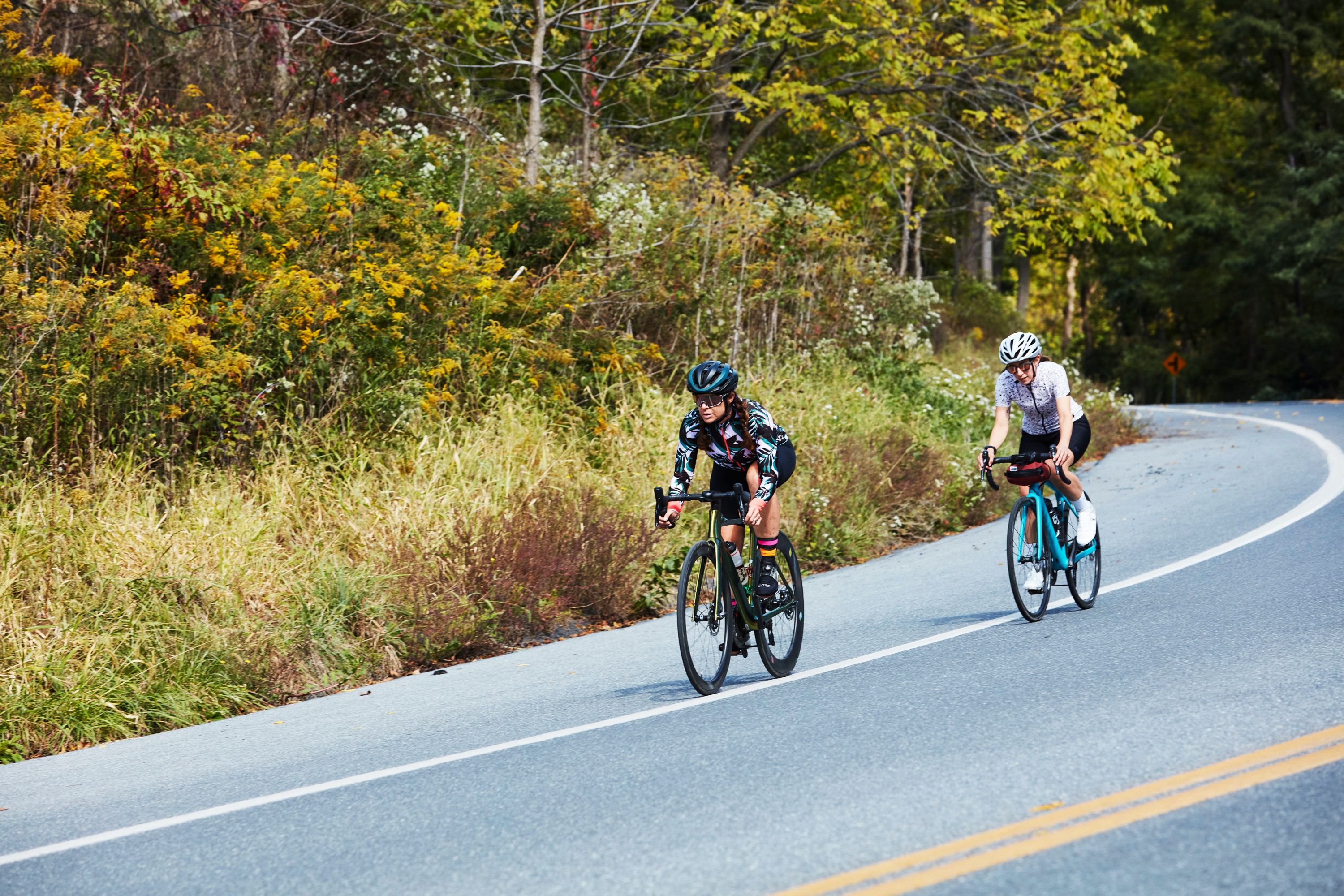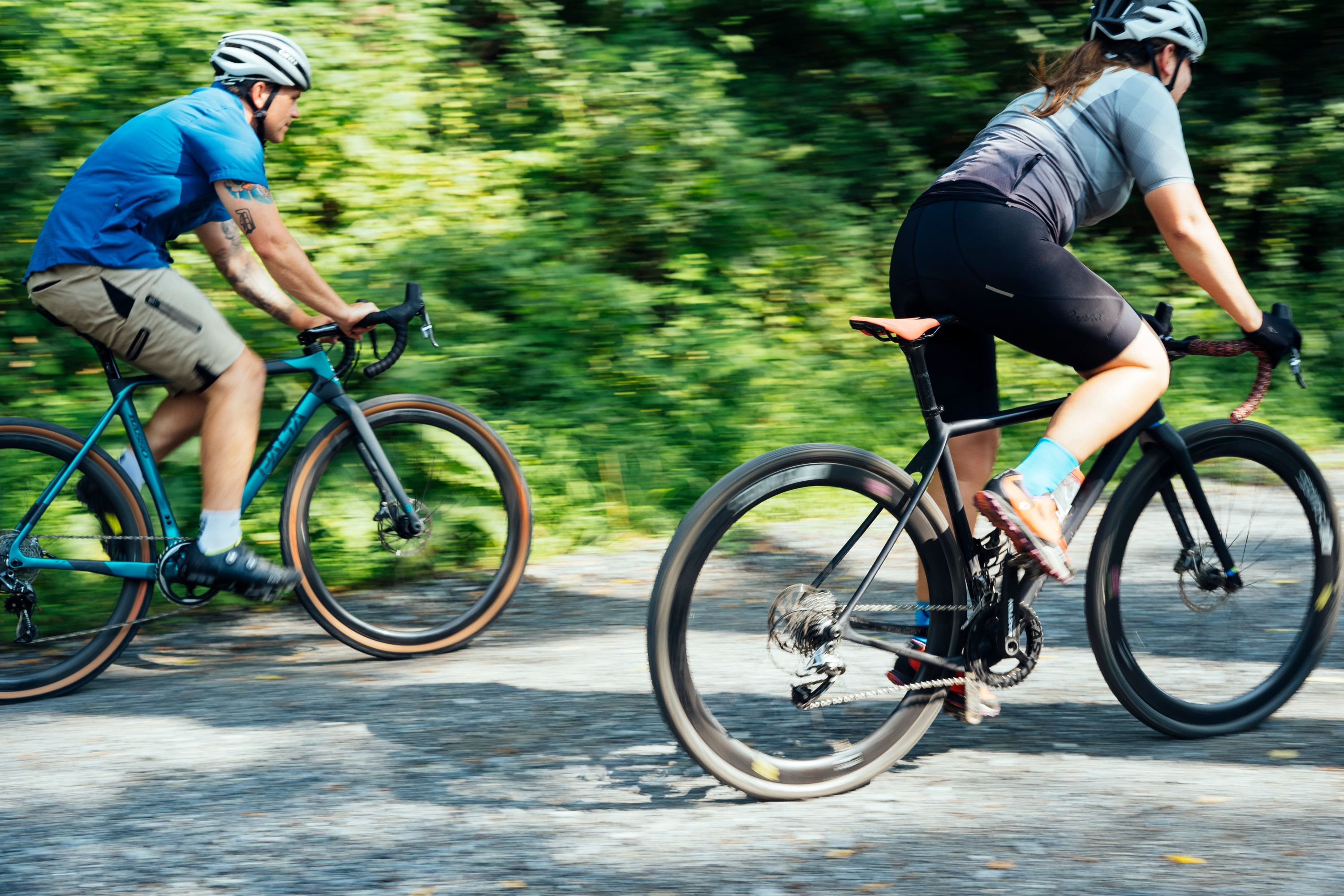Nail Your Drafting for More Efficient Riding
Drafting - sitting in the slipstream of one or many cyclists - is a key skill that will help you smash your race PBs.
You may know that drafting—getting close to the rider in front of you in order to take advantage of them blocking the wind for you—will help you ride faster and with less effort on your part. But if you’re newer to cycling, how do you draft another cyclist correctly (and safely!), whether you’re in a pack or just with one other rider?
One study from 2013 found that a cyclist can reduce their aerodynamic drag up to 27 percent by drafting one other cyclist. Meanwhile, a 2018 study found that aerodynamic drag can be reduced by up to 50 percent when drafting two cyclists; in a time trial situation, the fifth rider back gets the most benefit from drafting, and in that case even the leader gets a slight benefit. This can translate to saving enough energy to get through a group ride as a newer cyclist, or to having enough left in the tank to sprint with the pack and go for the win in a criterium race.
“I’m always asking, ‘Where can I not pedal? How can I pedal less so that when it is time to pedal, I can be more effective?’” CycleSmart founder and longtime cycling coach Adam Myerson told Bicycling. “In a criterium, if you can exit a corner on someone’s wheel in the draft, you save that energy you’d have to use otherwise to get back on that wheel. That move alone is probably the most important thing that I did in my career that allowed me to be successful with a smaller engine than most of the people around me.”
Myerson, 49, often credits his pack-riding skills and tactics for how he’s stayed competitive in the pro field for decades, admitting that he may not have the raw power that some of his competitors have, but he knows how to draft and corner with such precision that he’s always in the right position in a stacked crit field.
Here, Myerson shares his tips for drafting on a bike, whether you’re a new rider or you’ve been racing for years.

What’s the right drafting distance?
There’s no perfect formula for how much space to leave between your wheel and the rear wheel of the rider you’re drafting. At minimum, leave a few inches. There should never be an overlap between your front wheel and the rear wheel of the cyclist in front of you. But otherwise, go with your gut when learning how to draft. “I find it’s an organic thing that people adapt to,” Myerson says.
Myerson recommends grabbing a few friends and finding a safe and forgiving area (like a grassy field) to practice drafting and other skills. “Practice riding side by side, drafting at different distances, bump shoulders, even touch wheels slightly,” he says. Along with improving those skills, it’ll also help to reduce any panic you might feel when you come closer than you’d like to other riders.
Where to look while drafting
You may be tempted to focus solely on the wheel directly in front of you, but in addition to creating some terrible posture issues, that’s a dangerous place to look. You won’t be able to see what’s happening in the pack ahead of you, and if the rider in front of you brakes, you likely won’t notice until it’s too late—and that’s how crashes happen, Myerson notes. “Ideally, look two or three wheels ahead. Look past peoples’ hips at what’s happening in front of you. If you see the rider stop pedalling five riders in front of you, you know what’s coming and you can react,” he says.
This might be a scenario you don’t want to cop to, but Myerson likens drafting to tailgating: “Drafting is about your own comfort level and reaction time and ability to read what’s happening in front of you. If you’re someone who’s ever tailgated another car on the highway, you know that you need to be looking at the brake lights two or three or four cars ahead, in order to be able to react in time to what’s happening right in front of you. You have to predict slowdowns before they happen. Those same rules apply to drafting on a bike.”
What to do with your hands

Hoods, tops, or drops? When it comes to drafting, your hands should always be covering your brakes—which rules out riding on the tops for most. But hoods or drops is up to you, says Myerson. What’s best for you can depend on your experience level and your bike setup, particularly how high or low your hoods and brake levers are positioned.
“If you’re a new rider, you are likely not in a particularly aggressive position, and so it should be easy to reach the drops while still being comfortable and covering the brakes. It may not seem like it at first, but the drops are certainly a more stable position,” Myerson says. You can also be more aggressive with your steering while riding in the drops. Just make sure you can easily reach your brake levers.
“But I have noticed that many people are now setting their positions up entirely around riding holding the hoods—a more gravel- or cyclocross-style fit. And in that case, you’ll more likely want to be on your hoods, because it may be harder to reach the brake levers when you’re in the drops,” he says.
Modulating speed
Having your hands covering the brakes doesn’t mean slamming them on at the first sign of a slowdown. That’s an easy way to go OTB (over the bars) when learning how to draft another cyclist.
“Try to keep your hands relaxed over the brake levers, but ready… you’re looking to feather the brakes rather than slam the brakes on,” Myerson says. “You want to make subtle movements rather than sudden movements. Even before you brake, the first thing you might do is anticipate the slow up and stop pedalling. Get off the gas. That’s step one, rather than going full gas and then full brake.” You’ll also save more energy this way!
Drinking and drafting
Taking a sip from your bottle while staying neatly tucked in a draft can be tricky. This is why Myerson recommends first getting comfortable with taking your bottle in and out of the bottle cage while riding solo. You can even practice this on the trainer.
Get used to not looking down to grab it or to put it back, to create that muscle memory: Drinking on the bike is a skill! (“I sometimes mistake the unfriendliness of new riders who don’t wave back at me for what’s actually happening, which is they’re not yet capable of taking a hand off to wave. Just reaching for a bottle takes a while to learn how to do!” Myerson says.)
Once you’re comfortable solo, add in the drafting component. Keep one hand on a brake lever to modulate speed—Myerson recommends covering your rear brake, since it’s less powerful than the front and will allow you to better modulate your speed rather than slamming to a (potentially crash-inducing) stop. Put more space than you normally would between you and the rider in front of you, to give yourself more time to react.
“Pick the right moment to drink: If the field sitting up or if there’s a pause or you’re coasting for a moment, that’s a great time. Anytime you don’t have to pedal as hard to stay on the wheel is a great time to sneak a drink,” Myerson says.
Drafting etiquette in a group
Once you’re comfortable riding outside on your own without feeling wobbly, enlist a friend to ride with before jumping right into the super-speedy group ride, no matter how strong you are as a rider. “Look for friendly, no-drop group rides to get the experience of riding in a group,” Myerson says. “One of the things we lost in the pandemic, with people doing a lot of solo riding or indoor riding, is that communal experience of riding together. And then the minute you bring some people together to ride, drafting will automatically happen.”
If you’re in a group of riders and drafting confidently, you may still need to move around in the group—like going to the back in order to eat or drink, or to blow a snot rocket. Signal to those around you that you’re moving to the side. If you’re not positive of how to signal, in addition to making the hand motion, just say your intention out loud. Once you’re out of the draft, soft pedal until the group passes you and you can tuck into the back.

If you spend most of your miles exploring gravel, be careful when drafting, and give people a bit more space. “There’s much more risk drafting on gravel compared to drafting on the road. Things are less predictable,” says Myerson. “The person in front of you may be trying to do everything right, but may make a mistake that they can’t fix. The speeds might be slower at times, but there can be more danger.”
Drafting etiquette while riding solo
Coming up behind another rider while out on a solo ride is not the time to practice your drafting skills: In fact, drafting another rider is a breech of etiquette. “Treat that interaction the same way you would if you were walking near someone. You wouldn’t just run up right behind them and get into and stay in their personal space,” Myerson says. He doesn’t recommend asking, either.
It’s not just about etiquette, though. It’s also unsafe to draft a stranger, because you don’t know their riding capabilities or intentions. “They could be doing a workout where they might suddenly sit up or change speeds. They could abruptly take a turn, or veer around an obstacle without pointing it out. It can easily lead to a crash,” Myerson says.
Why other skills matter, too
Because of the COVID-19 pandemic, cycling saw a huge boom in ridership. But Myerson notes that many new cyclists—and even longtime racers—may be overpowered but underprepared when it comes to bike handling skills. “Even though there were no races, people were excited to train and they wanted to use that time to do some structured work,” he says. “People are strong, they’ve really built big engines. But they have not worked on their handling. They have been in group certain situations less often, and if they’re racers, they’ve lost a full season of racing.”
Having better bike handling skills all around is important, Myerson says. This includes drafting, but also cornering and dealing with obstacles, even in the context of drafting.
“When you’re riding in a draft or in a group, being able to take corners at speed or unweight over or around obstacles becomes part of staying safe,” he says. “Look for opportunities to work on your skills while you’re out on your ride, in a safe way. Focus on getting comfortable leaning the bike over in a turn, find some friends and go play bumper bikes in the grass. Learning how to fall as an adult without hurting yourself is important: I even tell people to take a tumbling class!”
“The better your bike handling is, the more you can predict what’s happening around you. The more you can be predictable, the closer you can draft. That’s all less energy you’ll spend to go the same speed,” Myerson says.
READ MORE ON: bunch skills drafting slipstreaming



